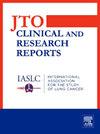可切除的早期NSCLC的新辅助、围手术期和辅助化学免疫治疗的3期试验:全面回顾和详细分析
IF 3.5
Q2 ONCOLOGY
引用次数: 0
摘要
新辅助、围手术期和辅助免疫检查点抑制剂联合化疗(ICI-CT)治疗可切除的早期非小细胞肺癌(eNSCLC)的3期试验报告显示,与单独使用CT相比,这三种方法均可获得无事件或无疾病的生存益处,并且具有可接受的安全性。这三种策略都是eNSCLC认可的护理标准。本综述提供了这些iii期ICI-CT试验的详细分析,并阐述了关于每种方法选择的考虑因素,包括方案方案、基线患者和肿瘤差异、术前分期、手术结果、疗效终点、安全性、治疗处置和程序性死亡配体1 (PD-L1)疗效生物标志物。在这些ICI-CT试验中,方案和研究人群之间的差异阻碍了交叉试验的比较,并强调了进行正面试验的必要性。无论后续治疗如何,通过新辅助ICI-CT获得病理完全缓解的患者有更好的生存结果,但实现病理完全缓解所需的术前ICI-CT周期的最佳次数尚未确定。在新辅助治疗或围手术期与辅助治疗方法之间的选择包括术前对手术的潜在损耗、术后对ICI-CT的损耗以及预期的毒性特征的风险-收益评估。目前浸润性淋巴结分期的局限性意味着辅助ICI仍然是一种重要的治疗策略,但术前淋巴结分期是必要的。未来的研究将确定围手术期试验中每个治疗阶段的安全性和毒性贡献,以确定术前或术后ICI入路是否更好,新辅助ICI- ct后辅助是否有额外的益处,以及哪种患者将从每种入路中获益最多。本文章由计算机程序翻译,如有差异,请以英文原文为准。
Phase 3 Trials of Neoadjuvant, Perioperative, and Adjuvant Chemoimmunotherapy for Resectable, Early-Stage NSCLC: Comprehensive Review and Detailed Analysis
Phase 3 trials of neoadjuvant, perioperative, and adjuvant immune checkpoint inhibitors combined with chemotherapy (ICI-CT) in resectable early-stage NSCLC (eNSCLC) have reported that all three approaches confer an event-free or disease-free survival benefit over CT alone, with acceptable safety profiles. All three strategies are approved standards of care for eNSCLC. This review provides a detailed analysis of these phase 3 ICI-CT trials and addresses the considerations regarding the selection of each approach, including protocol schema and baseline patient and tumor differences, preoperative staging, surgical outcomes, efficacy end points, safety, treatment disposition, and the programmed death-ligand 1 (PD-L1) efficacy biomarker. The differences between regimens and study populations among these ICI-CT trials hamper cross-trial comparisons and highlight the need for head-to-head trials. Patients achieving pathologic complete response with neoadjuvant ICI-CT have better survival outcomes irrespective of subsequent treatment, but the optimal number of preoperative ICI-CT cycles needed to achieve pathologic complete response has not been defined. The choice between a neoadjuvant or perioperative versus adjuvant treatment approach involves a risk-benefit assessment of the potential for preoperative attrition to surgery, postoperative attrition to ICI-CT, and the anticipated toxicity profile. Current limitations of invasive lymph node staging mean that adjuvant ICI remains an important treatment strategy, but preoperative node staging is imperative. Future studies that identify the safety and toxicity contributions of each treatment phase in perioperative trials will confirm whether a pre- or postoperative ICI approach is superior, whether there is added benefit to adjuvant after neoadjuvant ICI-CT, and which patients will benefit the most from each approach.
求助全文
通过发布文献求助,成功后即可免费获取论文全文。
去求助
来源期刊

JTO Clinical and Research Reports
Medicine-Oncology
CiteScore
4.20
自引率
0.00%
发文量
145
审稿时长
19 weeks
 求助内容:
求助内容: 应助结果提醒方式:
应助结果提醒方式:


